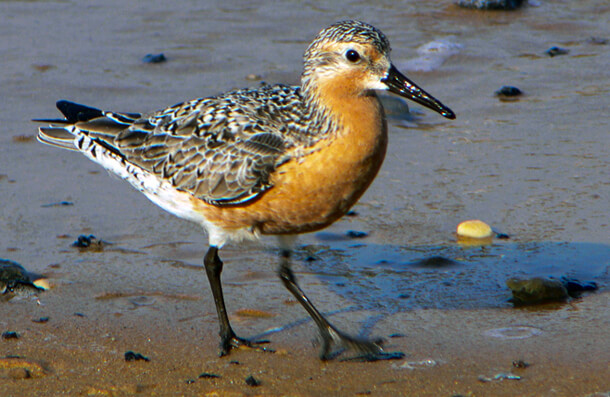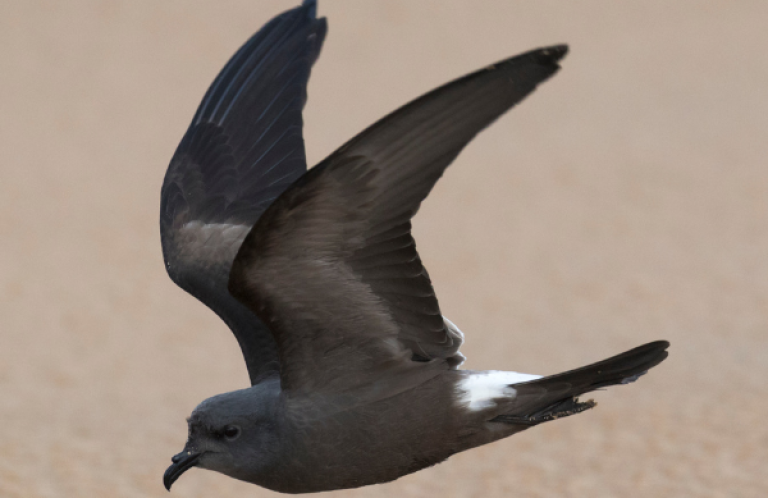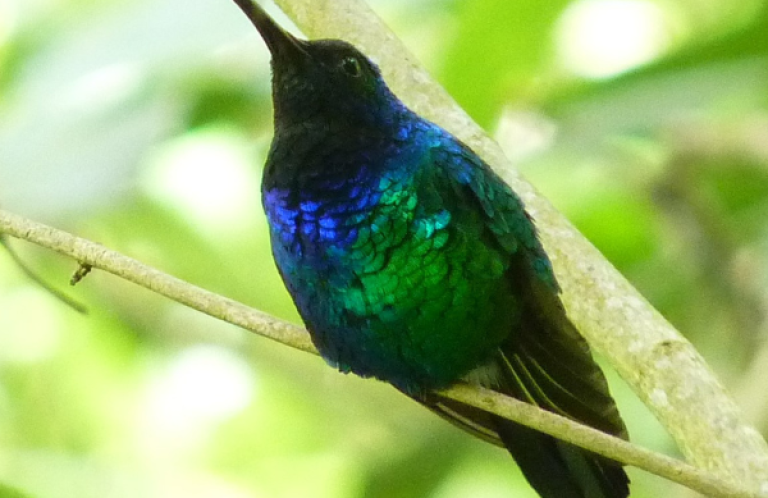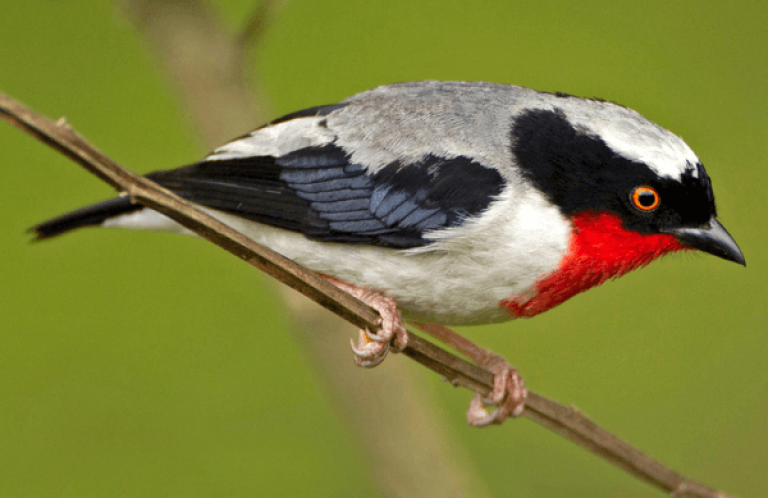Red Knot Wintering Population Drops by More than 5,000, Accelerating Slide to Extinction

Red Knot, Mike Parr
MEDIA RELEASE
Contact: Robert Johns, 202-888-7472, bjohns@abcbirds.org
Summary:
Scientists released a report announcing that a decrease of at least 5,000 Red Knots was observed at key wintering grounds in Tierra del Fuego, Chile from the previous year. Scientists reported population counts of wintering knots in other locations declined as well. The estimated current total population for the migratory shorebird is now unlikely to be more than 25,000.
The decline in Red Knot numbers elevates the importance of implementing stronger protections at Delaware Bay, a key U.S. stopover where migrating knots depend on an abundant supply of horseshoe crab eggs to fuel the final leg of their migration to breeding grounds in the Canadian Arctic.
The scientists' report concludes that despite horseshoe crab harvest restrictions put in place by the Atlantic States Marine Fisheries Commission over the past decade “there is still no evidence of recovery of the horseshoe crab population, either in numbers of spawning females or in all sub-adult age groups including juveniles.” Restrictions to date have only been enough to stop the population from declining further, are insufficient to recover the population and will continue to be insufficient unless the harvest is greatly reduced.
WASHINGTON – Conservation groups are calling on the U.S. Fish and Wildlife Service (FWS) to take immediate steps to list the Red Knot under the Endangered Species Act. A listing would initiate the development of a recovery plan and require federal agencies whose actions affect Red Knot to consult with the FWS. A listing would also require the Atlantic States Marine Fisheries Commission, housed under the National Marine Fisheries Service, to consult with the FWS on the regulations it establishes for the horseshoe crab fishery. The following are statements from groups pursuing an endangered species listing:
“This year's huge decline in wintering red knots provides clear evidence that the status quo is not working. Unless action is taken now, Red Knots may be on an irreversible slide to extinction,” said Bob Irvin, senior vice president for conservation programs at Defenders of Wildlife. “The U.S. has a responsibility to the global community to protect this migratory shorebird, which stops along our coast to rest and feed while making one of the longest migrations in nature, from the tip of South America to the Arctic.”
“The bad news demands we redouble our efforts to rebuild the horseshoe crab population of Delaware Bay,” said Tim Dillingham, executive director of the American Littoral Society. “A listing of the Red Knot under the ESA will allow for management of the horseshoe crab population to be directed toward recovery of the shorebird populations, and not simply the local fishing interests. We urge the USFWS to make this a priority.”
“Until recently, the Delaware Bay resplendent with spawning horseshoe crabs and over a million shorebirds was the land of plenty – our Serengeti,” said Eric Stiles, vice president for Conservation and Stewardship for New Jersey Audubon Society. “The Red Knot is one of the shorebirds whose very existence is teetering on the brink of survival. Unlike special interest naysayers, we have full faith in the Endangered Species Act. Only through listing will the robin-sized, chestnut colored shorebird be enjoyed by future generations.”
“The decline of the shorebirds and the horseshoe crabs that sustain them is not speculation; it is a proven reality documented by science and history. The Atlantic States Marine Fisheries Counsel, among those charged with protecting the species, has ignored the science and the harm in order to assuage their political allies. In the absence of strong and earnest action from the ASMFC, we need strong action from our states. While New Jersey has taken that strong action to protect the crabs and the birds, Delaware's actions leave a lot to be desired when the politics heats up,” said Maya van Rossum, the Delaware Riverkeeper.
“The Rufa Red Knot, which once darkened the skies during their migration, now stands on the very knife-edge of extinction. The states along the east coast, with the exception of New Jersey, dithered for decades and now the only way to save this subspecies is for the U.S. Fish and Wildlife Service to place it on the Endangered Species List. With this new report, it is clear that if the federal government doesn't act soon, the next generation of Americans will never see this amazing long-distance migrant. People who want to see this bird in the wild best make plans in the near future because the way things are going, it will be gone sooner rather than later,” said Darin Schroeder, vice president for Conservation Advocacy for ABC.
“A population decline this large and this rapid is almost unequalled in our lifetime,” said Greg Butcher, director of Bird Conservation for National Audubon Society. “Surely such a bird requires the immediate protection of the Endangered Species Act and needs to be a top conservation priority for all of us.”
"It's simple, to halt this decline and imminent extinction, we must list the red knot now and view all shorebird protection through the same lens," said Margaret O'Gorman, executive director for Conserve Wildlife Foundation.
Click here to read the report.
Background:
- Since 2005, four formal requests to list the Red Knot under the Endangered Species Act have been submitted to the FWS. Citing a lack of resources and other priorities, the Service failed to list the bird but placed it on the candidate list in 2006. Since then, red knot numbers have continued to fall.
- The decline of Red Knots and other shorebird species has been caused by a dramatically diminished supply of horseshoe crab eggs after millions of crabs were removed from the Bay beginning in the 1990s.
- When red knots leave Delaware Bay in poor condition due to the lack of horseshoe crab eggs, they either die before ever arriving in the Arctic or arrive in too poor a condition to successfully reproduce. As a result, adult birds are dying off without being replaced by juveniles, leading to a decline in population.
- Attempts to rebuild the Delaware Bay horseshoe crab population through reduced harvest quotas have to date been unsuccessful. The State of New Jersey implemented a moratorium on horseshoe crab harvesting in 2008. Since that time, the ASMFC has undermined the effect of New Jersey's moratorium by establishing quotas for Delaware, Maryland and Virginia that allow similar numbers of crabs to be harvested as prior to the moratorium.
- Governments and scientists from five other countries where Red Knots breed, stopover or winter are studying and working to address the other threats the species faces. At a recent meeting attended by many of the Knot experts, they agreed that rebuilding the horseshoe crab population at Delaware Bay by implementing a moratorium until recovery occurs is the top management priority.
- Red Knots are not the only species affected by the horseshoe crab fishery. Other species including sanderlings, ruddy turnstones, and semi-palmated sandpipers also depend on an abundant supply of horseshoe crab eggs at the Delaware Bay stopover. Each of these species has experienced significant declines as well.


















































